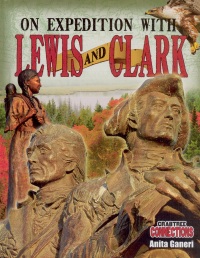| ________________
CM . . . . Volume XVII Number 40. . . .June 17, 2011. 
 |
On Expedition with Lewis and Clark. (Crabtree Connections).
Anita Ganeri.
St. Catharines, ON: Crabtree, 2011.
32 pp., pbk. & hc., $9.95 (pbk.), $20.76 (RLB.).
ISBN 978-0-7787-9917-7 (pbk.), ISBN 978-0-7787-9896-5 (RLB).
Subject Headings:
Lewis, Meriwether, 1774-1809-Juvenile literature.
Clark, William, 1770-1838-Juvenile literature.
Lewis and Clark Expedition (1804-1806)-Juvenile literature.
West (U.S.)-Discovery and exploration-Juvenile literature.
Explorers-West (U.S.)-Biography-Juvenile literature.
Grades 3-7 / Ages 8-12.
Review by Roxy Garstad.
***½/4
|
| |
|

excerpt:
In June, the expedition reached a fork in the river. Lewis and Clark decided to head south. A few days later, their way was blocked by a huge waterfall. It was impossible to cross by boat. Instead, they had to load the canoes on to carts and drag them around. Avoiding rattlesnakes, grizzly bears, and cacti, they reached safety, but it had taken a whole month. They needed to cross the Rocky Mountains before winter, and they were running out of time.
On Expedition with Lewis and Clark is among the latest additions to the "Crabtree Connections" series on geography, science, and history topics. The book introduces the nineteenth-century American explorers, Meriwether Lewis and William Clark, providing brief biographical information before launching on a detailed account of their 1804-1806 expedition across the Western United States. Within the first few pages, the reader discovers the purpose of this expedition, as stated by President Thomas Jefferson: "[to find] the most direct and practicable water communication across this continent, for the purposes of commerce" (p. 5). The text brings to the fore all of the most intriguing challenges the explorers and their corps faced from harsh winters bringing the crew to the brink of starvation, to quarrels with various First Nations peoples they met along the way. The text highlights their struggle against nature, culminating in their victorious arrival at the Pacific Ocean. The legacy of Lewis and Clark is described in the final pages, as the reader learns of the vast number of new animal and plant species they discovered, their descriptions of the geological wonders of the Rocky Mountains, and the relationships they formed with numerous Frist Nations groups. A description of the careers of Lewis and Clark after the expedition rounds out the text. An index and a glossary, defining words such as "keelboat," "dysentery," and "moccasins," are also included. The author encourages the reader to locate further information, providing links to web sites (all of which are still in working order as of the writing of this review), three books, and suggested historical sites that readers may want to visit in North Dakota, Oregon, and Missouri.
The text is arranged in short paragraphs, with graphic elements interspersed. At the bottom of each page is a timeline that allows the reader to follow events as they are described above in greater detail. The timeline augments the chronological arrangement of the content. Sidebars contain interesting facts, quotations from the explorers diaries, and highlights containing further information on topics mentioned in the main narrative. For instance, more detail is given about a group of First Nations that were encountered by the expedition members: "The Nez Perce are a Native American nation that originally lived in the Pacific northwest region of the United States. They spent winters living in villages. In summer, they traveled around in search of buffalo and salmon to hunt. Without the help of the Nez Perce, Lewis and Clark's expedition might have failed" (p. 23).
The images add interest and tend to support the text. A simple map near the beginning of the text places the Lewis and Clark journey in a greater visual context. Photographs are also utilized well, examples ranging from tools used by expedition members, to later photos of First Nations, to dramatic photos of "deadly rattlesnakes," adding suspense and intrigue to the text. Reproductions of paintings are shown, including formal portraits of key figures. Captions accompany the graphic elements.
Since the book describes an American expedition, it should be no surprise that the text is intended for an American reader. A photograph of a supposedly harsh Missouri winter would not appear particularly severe to Canadian eyes. Temperatures are provided in Fahrenheit, with Celsius in parentheses while miles are given before kilometres. The repeated use of "Native American" is not consistent with current Canadian usage. In addition, the First Nations are depicted as warrior peoples, completely conversant with the land and its challenges, which does little to revise the antiquated notion of the "Ecological Indian." The young Canadian reader can overcome these inconsistencies. Finally, the book should equally appeal to boys and girls who are interested in adventure and historical tales.
Recommended.
Roxy Garstad is a librarian at Grant MacEwan University in Edmonton, AB.

To comment on this title or this review, send mail to
cm@umanitoba.ca.
Copyright © the Manitoba Library Association. Reproduction for personal use is permitted only if this copyright notice is maintained. Any other reproduction is prohibited without permission.
NEXT REVIEW |
TABLE OF CONTENTS FOR THIS ISSUE- June 17, 2011.
AUTHORS |
TITLES |
MEDIA REVIEWS |
PROFILES |
BACK ISSUES |
SEARCH |
CMARCHIVE |
HOME |
